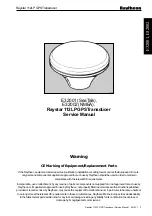
GPS-R35 User Manual
Levave
www.levave.com
Page 5 of 17
1.3.3. Firmware Characteristics
Items
Description
Core of firmware
SiRF version 2.3
Baud rate
9600
Code type
NMEA-0183
Datum
WGS-84
Protocol message &Output frequency
GGA(1Hz), GSA(1Hz), GSV(1Hz), RMC(1Hz),VTG(1Hz)
1.3.4 Interfaces
1) Dual channel RS-232 or TTL compatible level, with user selectable baud rate
(4800-Default, 9600, 19200, 38400).
2) NMEA 0183 Version 2.4 ASCII output (GGA, GSA, GSV, RMC, option GLL, VTG, ZDA).
3) Real-time Differential Correction input (RTCM SC-104 message types 1,2 and 9).
4) SiRF binary protocol.
2. Operational characteristics
2.1 Initialization
As soon as the initial self-test is complete, the
GPS-R35
begins the process of satellite
acquisition and tracking automatically. Under normal circumstances, it takes approximately
42 seconds to achieve a position fix, 38 seconds if ephemeris data is known. After a position
fix has been calculated, information about valid position, velocity and time is transmitted over
the output channel.
The
GPS-R35
utilizes initial data, such as last stored position, date, time and satellite
orbital data, to achieve maximum acquisition performance. If significant inaccuracy exists in
the initial data, or the orbital data is obsolete, it may take more time to achieve a navigation
solution. The
GPS-R35
Auto-locate feature is capable of automatically determining a
navigation solution without intervention from the host system. However, acquisition
performance can be improved as the host system initializes the
GPS-R35
in the following
situation:
1) Moving further than 500 kilometers.
2) Failure of data storage due to the inactive internal memory battery.
2.2 Navigation
After the acquisition process is complete, the
GPS-R35
sends valid navigation
information over output channels. These data include:
1) Latitude/longitude/altitude
2) Velocity
3) Date/time
4) Error estimates
5) Satellite and receiver status
The
GPS-R35
sets the default of auto-searching for real-time differential corrections in
RTCM SC-104 standard format, with the message types 1, 5, or 9. It accomplishes the
satellite data to generate a differential (DGPS) solution. The host system, at its option, may
also command the
GPS-R35
to output a position whenever a differential solution is available.





































